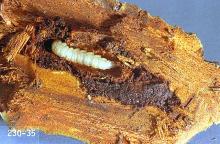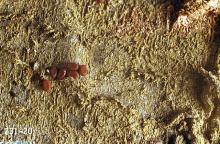Synanthedon exitiosa
Biology and life history The borer overwinters as a larva on or under the tree bark, usually below ground. As temperatures rise above 50°F in the spring, the larva resumes feeding on the tissues under the bark. At maturity in May and June, the larva pupates. Adult moths emerge beginning in June and continue through September. The adult is a metallic blue-black, clearwing moth. The male moth with a 1-inch wingspan may have bands of light-yellow scales on the abdomen, which makes it resemble a wasp. The female has a 1.25-inch wingspan and an orange band around the abdomen. Eggs are laid quickly after mating. Young larvae hatch after eight to ten days and bore immediately into the base of the tree. Larvae in the bark above the soil line usually do not survive the winter in cold areas.
Pest monitoring Monitor for flying clearwing moths by using pheromone traps starting in mid-June or watch for gummy frass at base of trees. This insect can do substantial damage if not controlled. Feeding damage made by one larva can kill a small tree.
Management-biorational control
Pheromone mating disruption (Isomate P) at 100-250 dispensers/A. Dispensers are placed in trees before first moth flight. Moth flight is usually from late June through September. If mating disruption is used, monitor blocks with traps baited with peachtree borer lures at one trap/2.5 A. If two or more moths are caught, a conventional insecticide application may be required.
Management-cultural control
Place a light metal or flexible plastic cone around the base of the tree before egg laying begins to protect it from larval entry. The cone is pushed 1 to 2 inches into the soil and should fit snugly around the trunk at the top to prevent the tiny larvae from getting beneath it. Budding tape or other flexible material helps seal the top. Alternatively, if only one or a few peach trees are involved in a home orchard, it is quicker and cheaper to control this insect by direct removal: use a pocketknife or some pointed instrument to remove dirt around the tree and dig out the larvae.
Management-chemical control
See Table 4 in:




